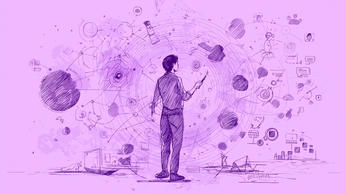
Navigating AI's Dual Nature: Harnessing Potential While Managing Risks
AI revolutionizes industries but brings job displacement and ethical challenges. By 2030, up to 30% of U.S. work hours could be automated. Learn how to harness AI's potential while managing its risks effectively.
AI is revolutionizing industries, but are we ready for its challenges? As artificial intelligence (AI) continues to evolve, it promises unprecedented efficiency and innovation. However, this technological shift also brings complex risks, from job displacement to ethical dilemmas. Let's delve into the dual nature of AI, offering insights and strategies for business professionals, consultants, changemakers, and C-suite executives to harness its potential while navigating its challenges.
The Impact of AI on Job Markets
By 2030, McKinsey predicts that up to 30% of hours currently worked in the U.S. economy could be automated, signaling significant job displacement. Goldman Sachs echoes this, estimating that 300 million full-time jobs could be lost or degraded due to AI automation. Yet, AI isn't just about loss; it's projected to create 97 million new jobs by 2025, emphasizing the critical need for upskilling to prepare the workforce for these new roles.
To illustrate, consider how AI might transform roles in customer service. While AI chatbots may handle routine inquiries, human agents could shift to more complex problem-solving and customer relationship management tasks, requiring new skills in data analysis and empathy.
Ethical Considerations in AI Development
AI's power to influence human decision-making extends beyond job markets. Platforms like TikTok use AI algorithms that shape our viewing habits, political opinions, and even social values. Yet, this influence raises concerns about social manipulation and surveillance, as Martin Ford points out:
The reason we have a low unemployment rate, which doesn’t actually capture people that aren’t looking for work, is largely that lower-wage service sector jobs have been pretty robustly created by this economy.
Eugenia Rho adds another layer of concern regarding human-AI interaction:
One of the deeper concerns surrounding LLMs in human-AI interaction is the potential erosion of genuine human connection.
These issues underscore the need for ethical frameworks and regulations. Pope Francis has called for an international treaty to regulate AI development, highlighting a global recognition of the need for responsible AI governance. The use of AI in autonomous weapons systems further complicates the ethical landscape, with over 30,000 individuals signing an open letter against their development in 2016.
Industry Applications and Case Studies
Despite these challenges, AI offers substantial benefits across industries. In construction, for instance, AI is revolutionizing processes and enhancing sustainability. Ali Shojaei notes:
AI has provided advantages and benefits not seen before, from the optimization of construction processes and productivity to improving safety protocols and advancing sustainable practices.
Such applications align with the principles of Exponential Organizations (ExO) as outlined in "Exponential Organizations 2.0," which emphasizes leveraging exponential technologies for transformative growth. Companies like Caterpillar are using AI to predict equipment failures, reducing downtime and costs while improving safety. For more insights on AI industry applications and case studies, explore real-world examples.
The Rapid Rise of Large Language Models (LLMs)
The development of large language models (LLMs) has been a key driver in recent AI advancements. By 2025, leading LLMs like OpenAI's GPT series, Google's Gemini, and Meta's Llama will have significantly transformed communication through text generation, language translation, and even code generation. These models, however, face challenges such as the need for human oversight and the potential for biases in training data. For a detailed understanding, refer to Large Language Models: What You Need to Know in 2025.
Geoffrey Hinton, a pioneering figure in AI, has expressed concerns about the rapid progress towards superintelligence, warning:
The idea that this stuff could actually get smarter than people... I thought it was way off... Obviously, I no longer think that.
These fears have led to calls for a moratorium on advanced AI development, supported by nearly 28,000 individuals, including Steve Wozniak and Elon Musk. For more on these concerns, see The Rapid Rise of AI: Concerns Over Superintelligence and Control.
Navigating AI's Risks and Opportunities
To effectively navigate AI's complexities, organizations must adopt a balanced approach. Here's how:
- Harness the power of exponential technologies like AI: Drive 10x growth by integrating AI into your business models and operations.
- Implement ExO methodologies: Use frameworks from "Exponential Organizations 2.0" to foster innovation and manage AI integration effectively and safely. For strategies on implementing Exponential Organizations methodologies for AI, explore further.
- Explore case studies and success stories: Learn from real-world examples of AI-driven transformations to inspire visionary thinking.
- Balance deterministic and constraint-based thinking: Address AI's ethical and societal implications with a thoughtful approach, considering both potential outcomes and limitations. For more on The Impact of AI on Human Decision Making and Society, delve deeper.
- Embrace abundance thinking: Focus on the potential for AI to unlock new opportunities and drive future industries forward.
Key Takeaways and Questions
-
How can companies effectively upskill their workforce to adapt to AI-driven changes?
Companies can invest in training programs focusing on skills like data analysis and machine learning, preparing employees for new roles created by AI.
-
What measures can be taken to prevent AI from being used for social manipulation and surveillance?
Implementing strict regulations and transparency requirements for AI algorithms can mitigate risks of manipulation and surveillance.
-
How can data privacy be protected in the context of AI tools?
Robust data protection laws and developing AI systems with privacy by design can safeguard user data.
-
What steps can be taken to mitigate AI biases and prevent them from exacerbating societal issues?
Using diverse datasets and regular audits of AI systems can identify and correct biases, ensuring more equitable outcomes.
-
What international regulations are needed to control the development and use of autonomous weapons?
An international treaty banning the development of lethal autonomous weapons could prevent their proliferation and misuse.
To keep up with the latest in the world of A.I, make sure to check out our AI industry daily news feed: https://openexo.com/feed/ai.
ExO Insight Newsletter
Join the newsletter to receive the latest updates in your inbox.








